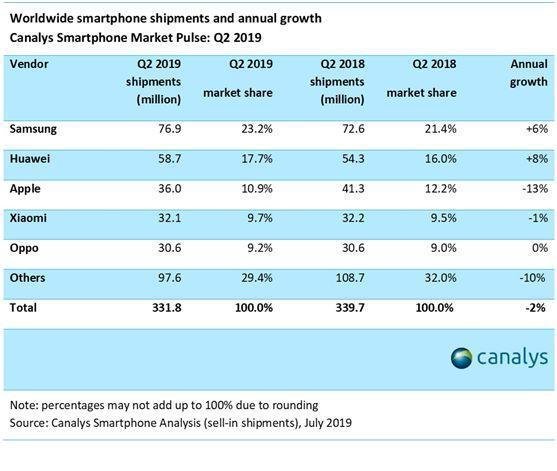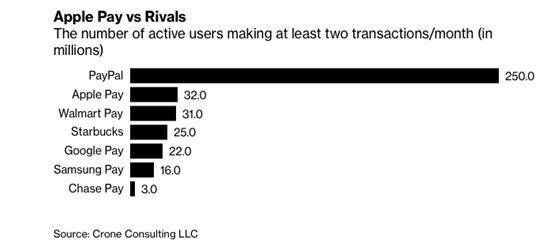Apple is becoming more and more short-sighted
At present, Apple is at a critical moment of reform, that is, the overall shipment of smartphones is declining, Huawei and Samsung of Android are fierce, and Apple's external environment is not particularly friendly.
Combing recent quarterly earnings reports and industry-related information, we are increasingly aware that Apple is moving away from the best time for change and towards the mediocrity of eating Jobs'old book and short-term cash.
Short-term operation secret: reduce prices and ensure growth
In Q2, guaranteeing growth has become one of Apple's most important tasks, mainly reflected in: 1. Reducing inventory, the stock at the end of last quarter was $4.9 billion, but the figure at Q2 was $3.3 billion; 2. Guaranteeing the speed of shipment, according to Canalys report, the number of iPhones shipped in the last quarter was 40.2 million and 36 million in Q2.
In absolute terms, sales of the iPhone are indeed slowing down, Q2 in 2019 is down 5.3 million units compared with the same period last year, and sales of the iPhone are also down from $31 billion in the last quarter to $26 billion in the current quarter.

Apparently, the price of the iPhone has been reduced to $722 from $771 in the last quarter, a considerable decline.
Considering the growing saturation of the global smartphone market, the high-end market has been seeking a full premium for the brand. Since the beginning of the iPhone X, its average price growth has entered the era of $700. In Q2 this year, the average price retracement should be noted.
The reasons are as follows:
First, Apple is loosening its grip on terminal prices.
In 2016, Apple officially canceled its online sales qualification for the reason of low-price sales on the Suning E-commerce line. At that time, Apple was like the sun, with strong control over terminal prices, and the almost non-discounted iPhone became a hard currency.
But since 2018, several major e-commerce platforms have been promoting low-cost iPhones frequently, and the government has hardly responded. So it can be seen that, on the premise of ensuring shipments and reducing inventory risk, Apple has basically abandoned the pricing power of terminal prices, and even the prices of official channels have begun to loosen.
The reason behind all this is that when Apple's original channel encounters the ceiling, the significance of e-commerce and various distributors'channels to Apple is naturally more than usual, and the dependence on third-party channels is increased, and the concessions to third-party channels are also increased.
Second, the price reduction did not reduce gross profit.
In Q2 this year, the gross margin of Apple's hardware is 30.4%, which is slightly lower than that of the same period last year, but not much different from 31.2% of Q1 this year. Apple's hardware still maintains a very high gross margin.
The price of a single phone dropped by 6.3%, but the gross profit did not decrease too much. It can be seen from the side that Apple's dependence on the profit of the iPhone is decreasing. In the first half of this year, shipments of smart wear and home hardware devices totaled $10.6 billion, compared with $7.6 billion in the same period last year, an increase of 39% in the total revenue ratio. More than 10%.
To some extent, this hedges the risk of the price reduction of the iPhone. CITIC Securities reported in 2018 estimated that the gross profit of AirPods was at least 50%. In addition to the attributes of Apple Watch and other products, the gross profit of smart wear and home should be no less than 50%. The new hardware alleviates the over-dependence of hardware on the iPhone.
In addition, after several rounds of shuffling, smartphone small and medium-sized brand companies have withdrawn, giants in OEM manufacturers and Supply Chain Pricing capacity has also increased, unit product costs are expected to reduce.
How long will Apple last?
In the above analysis, we can roughly draw the following conclusions: although the smartphone industry has encountered serious downward pressure, in the context of high margin, the iPhone can adjust the pace of shipment through price reduction, and other hardware can hedge the risks.
There are many risks, such as: first, insufficient control over terminal prices for fear of diluting the brand risk; second, the pressure on the shipment of the iPhone is still very high, the probability will exceed the speed of other hardware development, not grasping the rhythm of which is very prone to a systematic decline, hardware ring ratio decline is also said. Know the problem.
Even so, we still think that in the short term, Apple still has some room to move, and using gross margin at the expense of growth will have a certain effect in a period of time.
This is Cook's way of doing business: make full use of the brand in the early stage, use all means to maintain growth, but ignore the long-term development and stability.
In fact, Apple has been using service charges to reduce its dependence on hardware until now, but in 2019, the progress has not been very smooth.
In Q2 in 2019, service income was $11.455 billion, an increase of only $5 million compared with Q1, which was quite slow.
In recent years, the intention of the iPhone to charge for service is obvious, such as launching the payment tool Apple Pay, charging access fees with Tencent, charging access fees for live broadcasting on the iPhone and virtual props for short videos, etc. Apple tax has become a burden for content entrepreneurs to consider.
The shrinking of service charges in the first half of this year reflects that the iOS ecosystem built by Jobs has begun to loosen or even crack. With 36 million units still shipped in the quarter, service charges remain the status quo, and Apple's ARPU (average revenue per user) has substantially decreased.
More importantly, Apple's new format is progressing very slowly, which greatly slows down the growth of service income.
Apple Pay, for example, was born in 2014 and took the lead in mobile payment. But according to Bloomberg, only 60% of stores in the United States supported the payment tool until the end of 2018. According to professional estimates, Apple Pay uses 32 million users twice a month or more, while PayPal has 250 million users in the same period. By the end of 2018, about 31% of global iPhone users had activated this feature.

Apple Pay and his rivals in the United States (up to the end of 2018)
Wu Jun recently criticized Apple for "eating old Jobs" for so many years. After Jobs, it is hard for Apple to launch amazing products. The leading edge of smartphone products is declining. More importantly, the slack of operators inside and outside Apple makes the first-hand brand more and more likely to be damaged.
It's a short-sighted way to ensure growth by reducing prices. Cook certainly knows that increasing the proportion of service income is the right choice in the global smartphone growth bottleneck environment. But such a long-term layout seems unsuccessful nowadays, and there seems to be no better alternative to relying on Apple tax.
Today, Apple still has the brand that Jobs left behind, the margin can be reduced, and there are time windows for innovation. To sort out the situation in recent quarters, Apple executives represented by Cook have been quite skilled in using this time to make short-term earnings adjustments, such as price cuts to increase, but they have been regarded as the lifeline before. Strong operation, strong management and control of service income in addition to forcible collection of passage tax, but there is no new way to crack. If the upper and lower can not improve morale and operate the existing products well, then it is not far from the failure of the whole line.
Come on Cook, go on apples.